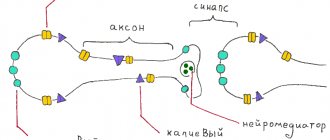March 11, 2021
The effect of smoking on the body has been proven many times. Everyone knows that “the Ministry of Health warns” that “Smoking is poison.” However, people are in no hurry to give up their addiction. According to statistics, the number of smokers on the planet is increasing daily. Perhaps many people do not fully understand why this is dangerous for them. Let's figure out what changes in the body occur when smoking. We will also find out whether it is possible to get rid of this addiction and how long it will take for the body to recover.
Deadly consequences of smoking
Since nicotine enters the human body in small doses, addiction develops, and there are no symptoms of acute poisoning1. During his life, a smoker smokes about 15 thousand lethal doses of nicotine. Urine harms almost all organ systems1.
This addiction increases the risk of coronary heart disease and hypertension by 4-6 times, and lung cancer by 101. Smokers are 5-8 times more likely to die from cardiovascular diseases and live on average 8-10 years less than non-smokers people1.
Every year, nicotine kills almost 5.5 million people in the world; on average, one person in the world dies from smoking every 6 seconds3. Smoking harms the health of not only those who smoke, but also those around them. Inhalation of cigarette smoke - passive smoking - annually leads to the death of 600 thousand non-smokers in the world4.
Next, we will look in detail at how smoking affects the body .
Up to contents
How much nicotine is in cigarettes
The range of lethal dose of the substance is from 50 to 100 mg. Recalling the drop of nicotine that killed the horse, toxicologists note that 2-3 drops are enough for a person. A person can get this amount of alkaloid from 1.5 packs of cigarettes.
How much nicotine is contained in 1 cigarette? The tobacco industry produces products of various strengths. The amount of nicotine in them ranges from 0.3 mg to 1.26 mg. For example, one Parliament cigarette can “supply” a smoker with 0.5 mg of nicotine, and a Marlboro “cancer stick” from a red pack can provide a smoker with 1.1 mg.
It is interesting that the strength of products in the line of one manufacturer can be determined solely as a subjective feeling. The filter of so-called light cigarettes has a larger number of perforations than their strong counterparts. This allows the smoker to draw in more air, due to which the concentration of nicotine and other toxic substances in the inhaled air becomes lower, and the taste is not so “rough”.
Another secret of “light” products: such products smolder on their own. The amount of tobacco gradually decreases, even if the person does not puff and just holds the cigarette in his hand.
The very idea of grading cigarettes was associated with an attempt by tobacco corporations to retain consumers: smoking light products was presented as a process of giving up a bad habit. In fact, people increased their daily number of cigarettes because they believed they were getting less tar and nicotine. According to the WHO Framework Convention, the labeling “light” and “soft” on the package is prohibited.
How does smoking affect the oral cavity?
Tobacco consumption causes a range of dental diseases and side effects. The effects of smoking on cavity are as follows:
- change in taste sensitivity;
- dark brown or black "smoker's plaque" on the teeth ;
- bad breath;
- gum diseases (periodontitis);
- leukoplakia of the mucous membrane (inflammation of the keratinization type);
- Oral cancer5 .
This effect of smoking on the oral cavity is due to the following factors:
- chemical—cigarette smoke contains more than 4,000 toxic compounds 5;
- thermal - due to high temperature (300°C for smoldering tobacco, 900-1000°C at the time of puffing and 40-60°C for tobacco smoke6), the blood supply to the gums is disrupted, which leads to hardening of blood vessels and atrophy of gum tissue5;
Smoking can lead to an unpleasant mouth condition called halitosis. The reasons for this are as follows:
- nicotine, tar and other products of tobacco combustion that linger in the oral cavity have a specific odor;
- a decrease in the amount of oxygen in the oral cavity caused by smoking leads to an increase in the number of anaerobic microbes, as well as to the breakdown of proteins;
- in smokers, the mucous membrane becomes dry - its desquamation increases;
- Smoking is a risk factor for the development of inflammation in periodontal tissues and the appearance of tartar6.
Smokers have an increased content of pathogenic microbes in cavity that affect periodontal tissue. A feature of the clinical picture of periodontitis is minor external signs of inflammation and at the same time a sharply progressive loss of bone tissue5.
It has also been proven that constant tobacco consumption increases the growth of fungi of the genus Candida, which leads to the development of candidiasis in cavity (identified in 60% of men and women with this bad habit)7.
Oral diseases in smokers have a worse prognosis, including cancer, not only because of the local influence of tobacco, but also because of the effect on the immune system - the content of immunoglobulins IgG and IgA in the blood decreases 6 .
Up to contents
The effect of smoking on the respiratory system
Tobacco tar, consisting of liquid and solid fractions, settles on the walls of the airways, accumulating in the alveoli of the lungs. Some of these compounds are released when coughing along with sputum, and some are absorbed into the tissues and enter the bloodstream6.
The lungs of smokers function worse than those of non-smokers. There is a narrowing of the bronchi, a violation of gas exchange develops and, as a result, oxygen deficiency8. According to the data described, as a result of pathological studies it was established that the lungs of a forty-year-old smoker look like the lungs of a non-smoker aged 75-80 years8.
The main symptoms of impaired functioning of the respiratory system due to smoking are chronic shortness of breath and cough with sputum. Often tobacco smoke is the cause of persistent breathing 9.
Bronchial asthma, chronic obstructive pulmonary disease, tuberculosis and pneumonia are what smoking can to . Tobacco negatively affects the course of these diseases: it contributes to the appearance of extensive damage to lung tissue and pronounced destructive changes9.
In recent years, there has been an increase in the incidence of lung cancer due to nicotine consumption, due to an increase in the number of not only active, but also passive smokers9.
There is a relationship between the frequency of consumption of tobacco products and the development of oncology of the respiratory system. Heavy smokers lung cancer 70 times more often than non-smokers10.
Up to contents
Risk of developing cancer due to smoking
The main harm of smoking (cigarettes, cigars and pipes) is their ability to cause cancer. This addiction can lead to malignant neoplasms 11:
- lungs;
- lips, tongue and other parts of the oral cavity;
- pharynx;
- larynx;
- esophagus;
- stomach;
- pancreas;
- liver;
- Bladder;
- kidney;
- cervix;
- colon.
In 30-35% of cases, nicotine is the main cause of the development of the above diseases11.
Tobacco smoke is the most common known carcinogen12 Smoking causes irreparable harm to the body : components of cigarette smoke are capable of forming mutagenic compounds with DNA, which lead to gene damage, the occurrence of mutations and the subsequent development of cancer12.
Tobacco consumption not only increases the risk of tumors , but also reduces life expectancy after cancer and increases the risk of relapse13.
Thus, quitting tobacco products helps prevent cancer: it helps prevent the emergence of new mutations , and also has a beneficial effect on the prognosis of existing cancers13.
Up to contents
A clinic where they can help
The harm of nicotine has long been proven, so you need to get rid of the habit. For 22 years, the IMC Addiction By Yuzapolsky clinic has been helping people get rid of addiction using specially developed proprietary methods. Specialists individually draw up a treatment plan according to the smoking history, psycho-emotional and physical condition of the patient.
Experienced neuropsychologists, narcologists, and psychotherapists work with each patient. There are rehabilitation programs for the patients themselves and their relatives. The clinic offers maximum comfort, there is a VIP department and single apartments. In this case, the treatment takes place completely anonymously. If you wish, you can choose an outpatient program.
The effect of smoking on the psyche
Human health also depends on the state of the psyche, which determines the level of intelligence, memory, personality traits, emotional background, and behavior.
One of the powerful factors that has a destructive effect on a person’s mental health is smoking. This is due to the active impact of various substances contained in tobacco smoke on the functioning of the brain and nervous system14.
In the first 10 seconds after inhaling smoke, nicotine penetrates the brain and begins to affect neurons - the working cells of the nervous system14. Nicotine acts as a master key, causing the brain to produce:
- Norepinephrine (NA) – acts as a stimulant. It determines the level of wakefulness of the brain and is responsible for concentration. NA increases blood pressure, increases heart rate and breathing, which contributes to the working mobilization of the body. This is why people who smoke believe that cigarettes help them concentrate better and improve their performance. However, without nicotine, smokers begin to experience difficulty concentrating.
- Serotonin is a neurotransmitter responsible for emotional stability. With its deficiency, a person becomes irritable, feels a lack of positive emotions, and has problems sleeping. Unexpected and unexplained tears and suicidal thoughts and actions may be associated with serotonin deficiency.
- Dopamine is commonly called the neurotransmitter of pleasure. This substance is produced at the moment when a person experiences satisfaction from what is happening. Dopamine is also responsible for kind feelings towards other people. With a lack of this neurotransmitter, a person perceives life as joyless and colorless, experiences an inability to love, and does not feel remorse about his own behavior.
- Gamma-aminobutyric acid is a substance that causes a feeling of calm. A lack of GABA leads to “free-floating anxiety” and panic attacks14.
When people start smoking, they experience a bitter taste in the mouth, a sore throat and cough, dizziness and headache, increased heart rate, and increased sweating. All this is a protective reaction of the body, as well as symptoms of nicotine poisoning. Gradually, the smoker adapts to this substance, the signs of intoxication disappear, and the need for a cigarette develops into a conditioned reflex, prompting the person to further self-poisoning. Each subsequent dose of nicotine, in turn, strengthens the acquired reflex. Thus, a vicious circle is created, the way out of which is to give up the bad habit14.
Up to contents
How quickly does nicotine leave the body?
After inhalation, nicotine is quickly absorbed into the bloodstream and reaches the brain within a few seconds. The half-life (the time during which the concentration of a substance drops by half) is about 2 hours. Depending on the length of smoking and the method of tobacco use, the rate of intake and metabolism may vary. Information about this helps to understand:
- with what frequency does a person feel the need to “take a drag”;
- how to choose the right therapy to alleviate withdrawal symptoms.
About 30% of the nicotine that enters the body is excreted unchanged, the remaining 70% in the form of non-toxic cotinine. The complete breakdown cycle of nicotine takes about 6-8 hours. When answering the question of how long nicotine is removed from the body, experts give a time frame of 1-2 days.
Interestingly, the name of the cotinine metabolite is an anagram of the word “nicotine.” The substance has an affinity for H-cholinergic receptors, providing a weak anti-anxiety and antipsychotic effect. Its half-life is up to 20 hours. The study of the duration of the last use of medications or smoking is assessed by the presence of cotinine and nicotine in the urine.
The effect of smoking on the cardiovascular system
Smoking and healthy blood vessels are two incompatible concepts. Nicotine increases the development of cardiovascular diseases such as:
- atherosclerosis;
- coronary heart disease (CHD);
- hypertension15.
Nicotine causes vasospasm, thereby increasing blood pressure. The walls of blood vessels are damaged, and cholesterol plaques are deposited on them. These factors are the main cause of the development of cardiovascular diseases, including myocardial infarction. The blood vessels in the smoker’s brain are also damaged - due to deterioration of blood supply, memory decreases and the risk of paralysis increases15.
Up to contents









